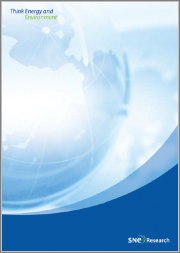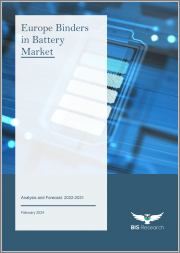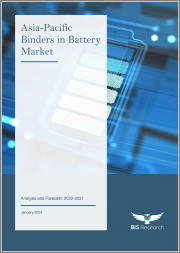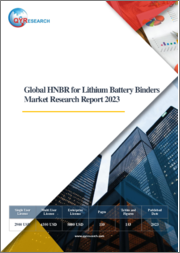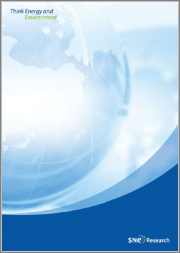
|
시장보고서
상품코드
1343613
<2023> 리튬이차전지용 바인더 기술개발 현황 및 전망<2023> Development Status and Outlook of Binder Technology for Secondary Batteries |
||||||
리튬이온전지(LIB)는 높은 에너지밀도와 전력밀도로 인해 전기자동차 및 하이브리드 장치에서 사용되는 에너지저장 수요 증가를 해결하기 위해 가장 유망한 에너지저장장치의 하나로, 탄소저감을 위한 친환경 에너지 활용에 대한 관심의 증가와 함께 그 사용량이 급격히 늘고 있습니다.
SNE Research에 따르면, 새로운 에너지저장장치와 전기자동차의 급속한 발전 이후 LIB에 대한 수요는 꾸준히 증가하여 전기차 배터리 시장 규모는 연평균 21% 성장하며, ‘25년 196B$에서 ‘30년 401B$로 성장할 것으로 전망됩니다.
LIB의 특성은 전극에 따라 크게 좌우되는데, 뛰어난 배터리 성능을 달성하기 위해서는 전극구조를 최적화하는 것이 최우선 과제라고 할 수 있습니다. 현재 상용화된 LIB에서 뿐만 아니라 연구분야에서도 양극과 음극의 활물질은 많은 관심과 함께 연구 및 검토되고 있는데 비해, 비활성인 바인더는 낮은 중량비(≤5wt%)로 전극의 온전함을 유지하고 전기화학적 공정을 지원하며, 활물질과 도전재와 함께 전극의 성능 구현 측면에서 중요한 위치를 차지하지만 중요성에 비해 덜 주목받고 있는 것이 현실입니다.
바인더는 전극 내에서 차지하는 부분이 매우 작은 편이지만, 전극 전체 성능을 결정짓는 중요한 역할을 합니다. 바인더는 양극 및 음극의 활물질 및 도전재를 집전체인 각 극판에 잘 부착시키고, 내구성을 높이는 역할을 합니다. 바인더는 (1)전해질에 전기화학적으로 안정적이여야 하고, (2)유연성과 불용성을 가져야 하며, (3)특히 양극 바인더의 경우 산화에 의한 부식방지 기능이 있어야 합니다.
따라서, 활물질과 도전재를 집전체와 효과적으로 연결하고 부피 팽창을 수용하여 충방전 동안 우수한 전극 구조를 보장할 수 있는 높은 결합강도와 탄성을 지닌 기능성 바인더가 필요합니다. 최근 바인더 스크리닝(screening) 및 설계에 대한 더 많은 통찰력을 통해 연구의 초점이 기계적 안정화 관점에서 구조적 지지체 뿐만 아니라 전기화학적으로 이점을 제공하는 다기능성으로 이동하고 있습니다.
최근, 실리콘 음극재 채택이 늘어나면서 바인더가 리튬화(lithiation)반응에 많은 영향을 주어 전극 용량 및 사이클 안성성 향상에 도움이 된다는 연구가 나와 차세대 연구가 활발히 진행되고 있습니다. 기존 바인더는 양극재에는 주로 불소수지인 PVDF(PolyVinyliDeneFluoride)를, 음극재에는 합성고무인 SBR(Styrene-Butadiene-Rubber)과 CMC(Carboxyl Methyl Cellulose) 바인더를 사용했으나, 실리콘 음극재에서는 부피변화가 커서 사용에 부적합합니다.
최근에 양극재에는 PTFE(PolyTetraFluoroEthylene)바인더가 음극재에는 PAA(PolyAcrylicAcid), PI(PolyImide)계 등 수계 바인더 등이 각광을 받고 있습니다.
PAA, PI 등의 바인더는 수계 바인더로, 물 기반 수계 용매를 전해질로 사용하는 실리콘 음극재에 사용됩니다. 위 바인더들은 기존 바인더에 비해 인장강도가 높고, 접착력이 높아 실리콘 음극재의 부피 팽창에 강하며 활물질을 감싸서 안정적인 SEI(Solid Electrolyte Interphase)층을 형성합니다.
차세대 양극재용 바인더인 PTFE는 건식 전극공정용 바인더로 내화학성, 내열성이 매우 뛰어난 소수성 소재로 건식 전극공정이나 전고체전지에서 주목받을 것으로 보입니다.
PVDF 바인더는 일본의 Kureha, 벨기에의 Solvay, 프랑스의 Arkema가 생산하고 있으며, SBR 바인더는 일본의 Zeon에서 생산하고 있어 모두 외국산 비중이 높은 고가 품목입니다.
양극재 바인더는 국내의 켐트로스, 음극재 바인더의 경우 국내의 한솔케미칼이 국산화에 성공하여 삼성SDI와 SK On에 공급하고 있으며, LG Chem.과 금호석유화학도 음극재 바인더 공급에 나서고 있습니다.
한편 SNE Research의 글로벌 리튬이온전지용 바인더 수요 전망을 보면, 2025년 89,000톤에서 2030년 232,000톤으로 증가할 것으로 전망되며, 금액으로는 2030년에 약 4.4조원이 될 것으로 전망하고 있습니다.
고에너지밀도 배터리는 고성능 바인더에 대한 요구사항이 더 높아질 것으로 예상되며, 이러한 관점에서 바인더 설계는 다음을 고려해야 합니다.
(1) 기계적 강도와 접착력을 잃지 않고 바인더 함량은 전체 전극 질량의 3wt%이하 일 것. (2) 저비용 및 지속 가능’25년 성 관점에서 수계 및 건식 기반 고분자를 이용한 합성의 단순화. (3) 필요한 모든 기능을 하나의 고분자에 통합할 수 있는 다기능성 고분자 바인더. (4) 고분자 분산 및 분해 메커니즘에 대한 깊은 통찰력 등 입니다.
본 리포트에서 SNE는 리튬이온 전지 전극을 위한 바인더 설계, 합성 및 전지에의 적용에 대한 지금까지의 문헌에 나온 정보를 상세하게 정리하였으며, 당사의 리튬이온 전지에 대한 전망자료를 기초로 바인더에 대한 수요 및 시장을 전망하였으며, 부록에는 외부 리서치 기관의 시장규모 및 전망을 인용하여 독자들이 전체적인 규모를 파악하는데 도움을 주고자 하였습니다.
마지막으로, 바인더 제조업체의 현황 및 주요 제품을 정리함으로써 이 분야의 연구자 및 관심있는 분들에게 전체적인 통찰력을 제공함으로써 전지의 에너지밀도, 급속 충전 능력 및 장기 수명 특성 등 전지의 성능을 향상시키는데 큰 도움이 될 것으로 기대합니다.
본 보고서의 Strong Point
- ① 바인더에 대한 전반적인 개요 및 풍부한 기술내용 수록
- ② 바인더의 개발사례를 통해 핵심 point인 설계, 합성 시 고려 사항을 수록
- ③ LIB뿐만 아니라 차세대 전지인 Li-S나 전고체전지용 바인더 개발 현황 및 사례 분석 정리
- ④ SNE Research의 배터리 전망치에 근거한 객관적인 바인더 시장 전망을 통해 바인더 시장에 대한 객관적인 수치 제공
- ⑤ 주요 바인더 기업 개발 현황 및 제품 현황에 대한 상세한 정보 수록
목 차
1. 바인더 개요
- 1.1. 서론
- 1.2. 정의, 역할 및 요구물성
- 1.2.1. 역할 및 기능
- 1.2.2. 요구 물성
- 1.3. 유형 및 종류
- 1.3.1. 유형(types)
- 1.4. 작동 메커니즘
2. 바인더의 종류 및 연구개발 사례
- 2.1. 양극 바인더
- 2.1.1. 비수계 바인더
- 2.1.2. PVDF양극 바인더 산업 현황
- 2.1.3. (CMC+SBR) 음극 바인더 산업 현황
- 2.1.4. 수계 바인더
- 2.1.5. 기타 바인더황
- 2.2. 음극 바인더
- 2.2.1. 삽입형 음극 바인더
- 2.2.1.1. 흑연전극용 바인더
- 2.2.1.2. LTO전극용 바인더
- 2.2.2. 합금형 음극 바인더
- 2.2.2.1. 선형 고분자 바인더
- 2.2.2.2. 가교 고분자 바인더
- 2.2.2.3. 갈래(분지) 및 초대형 고분자 바인더
- 2.2.2.4. 전도성 고분자 바인더
- 2.2.1. 삽입형 음극 바인더
- 2.3. 차세대 전지용 바인더 (1)
- 2.3.1. 리튬-황 전지용 바인더
- 2.3.2. 건식공정용 바인더
- 2.4. 차세대 전지용 바인더 (2)
- 2.4.1. 고체전해질용 바인더
- 2.4.1.1. 전고체전지 개요
- 2.4.1.2. 황화물계 전고체전지
- 2.4.1.3. 전고체전지 제조 및 바인더의 필요성
- 2.4.1.4. 양극용 바인더 기술
- 2.4.1.4.1. 습식공정용 바인더 기술
- 2.4.1.4.2. 건식공정용 바인더 기술
- 2.4.1.5. 전해질층용 바인더 기술
- 2.4.1.6. 음극용 바인더 기술
- 2.4.1.6.1. 흑연기반 음극 바인더 기술
- 2.4.1.6.2. 차세대 음극 바인더 기술
- 2.4.1. 고체전해질용 바인더
3. 바인더 시장
- 3.1. 바인더 시장 전체 전망
- 3.2. 글로벌 LIB용 바인더 시장 전망
- 3.2.1. 글로벌 배터리 시장 수요
- 3.2.2. 글로벌 LIB배터리용 바인더 수요 전망
- 3.2.3. LIB배터리용 바인더 가격 전망
- 3.2.4. LIB배터리용 바인더 시장규모 전망
- 3.2.5. 글로벌 LFP배터리 수요 및 양극재 수요 전망
- 3.2.6. LFP 배터리용 PTFE 가격 및 시장 전망
- 3.2.7. LFP 배터리용 PTFE 바인더 사용량
- 3.2.8. 실리콘계 음극용 바인더 시장 전망
- 3.2.9. 실리콘계 음극재 시장 전망
- 3.2.10. 실리콘 음극용 바인더PAA 시장 전망
- 3.2.11. Tesla향 4680 전지용 바인더 코스트 분석
- 3.2.12. PVDF binder 제조기업들의 출하량 및 M/S
- 3.2.13. SBR binder 제조기업들의 출하량 및 M/S
- 3.2.14. CMC binder 제조기업들의 출하량 및 M/S
4. 바인더 제조업체 현황
- [1] Arkema
- [2] BASF SE
- [3] Solvay
- [4] Kureha
- [5] ZEON
- [6] JSR
- [7] Fujian Blue Ocean Black Stone
- [8] Dupont
- [9] Ashland Inc
- [10] MTI Corp.
- [11] TRINSEO
- [12] Xinxiang Jinbang Power Technology
- [13] Lihong Fine Chemical
- [14] 켐트로스
- [15] 한솔케미칼
- [16] 금호석유화학
- [17] Daikin Industry
- [18] Nanografi Nano Technology
- [19] Nippon Paper Group
- [20] APV Engineered Coatings LLC
- [21] Sichuan Indigo Materials Science & Technology
- [22] Guangzhou Songbai Chemical Co
- [23] Nippon A&L Inc
- [24] Daicel Miraizu Ltd
- [25] Sinochem Group Co
- [26] Ube Corp.
- [27] AOT Battery Equipment Technology
- [28] Shanghai 3F New Materials
- [29] GL Chem
5. 부록(참고용)
6. References
Lithium-ion batteries (LIBs) are one of the most promising energy storage devices to address the growing demand for energy storage in electric vehicles and hybrid devices due to their high energy and power density, and their use is increasing rapidly with the growing interest in utilizing green energy for carbon reduction.
According to SNE Research, after the rapid development of new energy storage devices and electric vehicles, the demand for LIBs has been steadily increasing, and the electric vehicle battery market size is expected to grow from $196B in '25 to $401B in '30, with a CAGR of 21%.
The characteristics of LIBs are highly dependent on the electrodes, and optimizing the electrode structure is a top priority to achieve superior battery performance. While the active materials of the anode and cathode are currently being studied and examined with great interest in commercialized LIBs as well as in research, the inactive binder, which maintains the integrity of the electrode and supports the electrochemical process at a low weight fraction (≤5wt%), occupies a critical position in the performance of the electrode along with the active materials and conductors, but has received less attention compared to its importance.
Although binders are a very small part of the electrode, they play a critical role in determining the overall performance of the electrode. The binder is responsible for the adhesion of the anode and cathode active materials to the respective pole plates of the collector and for their durability. The binder must be (1) electrochemically stable in the electrolyte, (2) flexible and insoluble, and (3) resistant to corrosion by oxidation, especially for cathode binders.
Therefore, a functional binder with high bond strength and elasticity is required to effectively connect the active material and the conductor to the collector and accommodate volume expansion to ensure good electrode structure during charge and discharge. Recently, with more insights into binder screening and design, the focus of research is shifting from a mechanical stabilization perspective to multifunctionality that provides electrochemical benefits as well as structural support.
Recently, with the increasing adoption of silicon cathode materials, a new generation of research is underway, as studies have shown that binders have a significant impact on the lithiation reaction, helping to improve electrode capacity and cycleability. Conventional binders mainly use PVDF (PolyVinyliDeneFluoride), a fluoroplastic, for the cathode and SBR (Styrene-Butadiene-Rubber) and CMC (Carboxyl Methyl Cellulose) binders, a synthetic rubber, for the anode, but they are not suitable for use in silicon anodes due to large volume changes.
PTFE (PolyTetraFluoroEthylene) binders have been used for cathode materials, and water-based binders such as PAA (PolyAcrylicAcid) and PI (PolyImide) have been attracting attention for anode materials.
Binders such as PAA and PI are water-based binders, which are used in silicon anode materials that use water-based solvents as electrolytes. Compared to conventional binders, these binders have high tensile strength, high adhesion, and are resistant to volume expansion of silicon anode materials and form a stable SEI (Solid Electrolyte Interphase) layer by wrapping the active material.
PTFE, a next-generation binder for cathode materials, is a hydrophobic material with excellent chemical and heat resistance and is expected to gain attention in dry electrode processes and all-solid-state batteries.
PVDF binders are produced by Kureha in Japan, Solvay in Belgium, and Arkema in France, and SBR binders are produced by Zeon in Japan, all of which are expensive items with a high proportion of foreign production.
The cathode binder is produced by Korea's Chemtros, and for the anode binder, Korea's Hansol Chemical has successfully localized it and is supplying it to Samsung SDI and SK On, while LG Chem. and Kumho Petrochemical are also supplying cathode binders.
Meanwhile, SNE Research's global demand forecast for binders for lithium-ion batteries is expected to increase from 89,000 tons in 2025 to 232,000 tons in 2030, with a value of about KRW 4.4 trillion in 2030.
High-energy-density batteries are expected to place higher requirements on high-performance binders, and from this perspective, binder design should consider the following.
- (1) The binder content should be less than or equal to 3 wt% of the total electrode mass without losing mechanical strength and adhesion.
- (2) Simplification of synthesis using water-based and dry-based polymers from the perspective of low cost and sustainability.
- (3) Multifunctional polymer binders that can integrate all necessary functions into one polymer.
- (4) Deep insights into polymer dispersion and degradation mechanisms, and more.
In this report, SNE has summarized in detail the information available in the literature on the design, synthesis, and application of binders for lithium-ion battery electrodes and forecasted the demand and market for binders based on our forecasts for lithium-ion batteries, and quoted market size and forecasts from external research organizations in the appendix to help readers understand the overall scale.
Finally, by summarizing the status of binder manufacturers and their main products, we hope to provide a holistic insight for researchers and interested parties in this field, which will help to improve the performance of batteries, including their energy density, fast charging capability, and long-term life characteristics.
Strong points of this report:
- (1) Provides a general overview of the binder and contains rich technical content
- (2) Includes key points to consider in design and synthesis through examples of binder development.
- (3) Summarizes the development status and case analysis of binders not only for LIBs but also for next-generation batteries such as Li-S and all-solid-state batteries.
- (4) Provides objective figures on the binder market through objective binder market forecasts based on SNE Research's battery forecasts.
- (5) Detailed information on the development status and product status of major binder companies.
[Shipments and M/S of PVDF binder manufacturers]
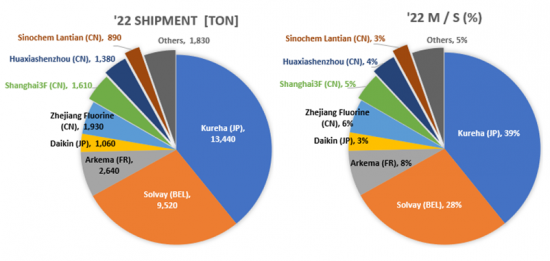
[Shipments and M/S of SBR binder manufacturers]
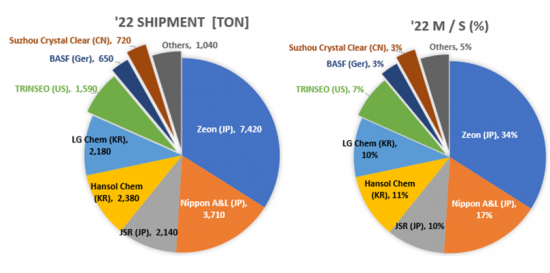
[Binder cost analysis for 4680 cells for Tesla]
- Cathode: NCM811, Anode: Si series
- PVDF cathode binder consumption and cost for a 1 GWh cell: Approx. 38 tons, KRW 1.546 billion
- PAA anode binder consumption and cost for a 1 GWh cell: Approx. 24 tons, KRW 0.823 billion

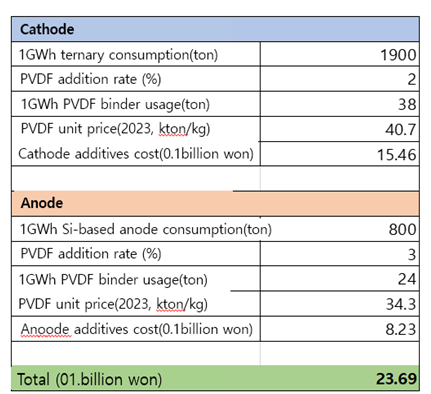
[A schematic of the dry and wet processes for electrode fabrication]
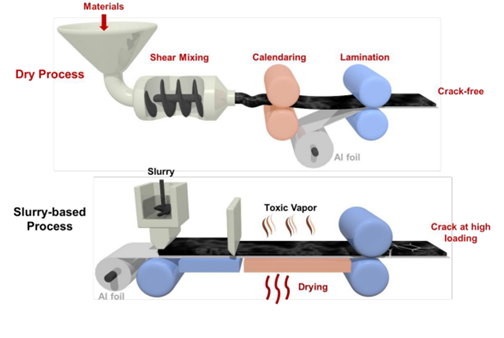
Table of Contents
1. Binder Overview
- 1.1. Introduction
- 1.2. Definition, Role, and Requirements
- 1.2.1. Role and Features
- 1.2.2. Requirements
- 1.3. Categories and Types
- 1.3.1. Types
- 1.4. Operation Mechanism
2. Types of binders and R&D practices
- 2.1. Binders for Cathodes
- 2.1.1. Non-Aqueous Binders
- 2.1.2. Industry Status of PVDF Cathode Binders
- 2.1.3. (CMC+SBR) Industry Status of Anode Binders
- 2.1.4. Water-based Binders
- 2.1.5. Other binders
- 2.2. Binders for Anodes
- 2.2.1. Insertable Anode Binder
- 2.2.1.1. Binders for Graphite Electrodes
- 2.2.1.2. Anode Binder for LTO
- 2.2.2. Alloy Anode Binders
- 2.2.2.1. Linear Polymer Binders
- 2.2.2.2. Crosslinked Polymer Binders
- 2.2.2.3. Branched and Extra-Large Polymer Binders
- 2.2.2.4. Conductive Polymer Binders
- 2.2.1. Insertable Anode Binder
- 2.3. Binder for Next-Generation Batteries (1)
- 2.3.1. Binders for Lithium-Sulfur (Li-S) Batteries
- 2.3.2. Binders for Dry Process
- 2.4. Binder for Next-Generation Batteries (2)
- 2.4.1. Binders for Solid Electrolytes
- 2.4.1.1. Overview of All-Solid-State Batteries
- 2.4.1.2. Sulfide-based All-Solid-State Battery Technology
- 2.4.1.3. Manufacturing of All-Solid-State Cells and the Purpose of Binders
- 2.4.1.4. Binder Technology for Cathodes
- 2.4.1.4.1. Binder Technology for Wet Processes
- 2.4.1.4.2. Binder Technology for Dry Processes
- 2.4.1.5. Binder Technology for Electrolyte Layers
- 2.4.1.6. Binder Technology for Anodes
- 2.4.1.6.1. Binder Technology for Graphite-Based Anodes
- 2.4.1.6.2. Next Generation Binder Technology for Anodes
- 2.4.1. Binders for Solid Electrolytes
3. Binder Market
- 3.1. Overall Outlook for the Binders Market
- 3.2. PVDF Market Outlook for Global LIBs
- 3.2.1. Global Battery Market Demand
- 3.2.2. Global LIB Battery Binder Demand Outlook
- 3.2.3. LIB Battery Binder Price Outlook
- 3.2.4. LIB Battery Binder Market Size Outlook
- 3.2.5. Global LFP Battery Demand and Cathode Material Demand Outlook
- 3.2.6. PTFE for LFP Batteries Price and Market Outlook
- 3.2.7. PTFE Binder Usage for LFP Batteries
- 3.2.8. Market Outlook for Binders for Silicon-based Cathodes
- 3.2.9. Silicon-based Anode Material Market Outlook
- 3.2.10. PAA Binders for Silicon Anode Market Outlook
- 3.2.11. Binder cost analysis for 4680 batteries for Tesla
- 3.2.12. Shipments and M/S of PVDF Binder Manufacturers
- 3.2.13. Shipments and M/S of SBR Binder Manufacturers
- 3.2.14. Shipments and M/S of CMC Binder Manufacturers
4. Binder Manufacturer Status
- [1] Arkema
- [2] BASF SE
- [3] Solvay
- [4] Kureha
- [5] ZEON
- [6] JSR
- [7] Fujian Blue Ocean Black Stone
- [8] Dupont
- [9] Ashland Inc
- [10] MTI Corp.
- [11] TRINSEO
- [12] Xinxiang Jinbang Power Technology
- [13] Lihong Fine Chemical
- [14] Chemtros
- [15] Hansol Chemical
- [16] Kumho Petrochemical
- [17] Daikin Industry
- [18] Nanografi Nano Technology
- [19] Nippon Paper Group
- [20] APV Engineered Coatings LLC
- [21] Sichuan Indigo Materials Science & Technology
- [22] Guangzhou Songbai Chemical Co
- [23] Nippon A&L Inc
- [24] Daicel Miraizu Ltd
- [25] Sinochem Group Co
- [26] Ube Corp.
- [27] AOT Battery Equipment Technology
- [28] Shanghai 3F New Materials
- [29] GL Chem
5. Appendix [For reference]
6. References
(주말 및 공휴일 제외)











